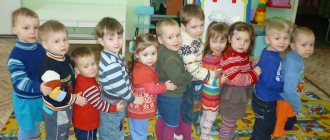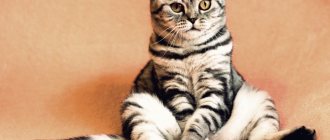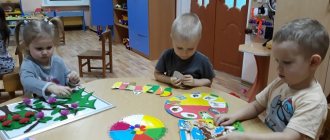Summary of a lesson on cognitive development “Insects”. Middle group
Abstract of GCD on cognitive development with elements of REMP.
Topic: “Insects. Purpose: to give an idea about insects. Objectives: • clarify children's understanding of insects: their appearance, lifestyle, habitat, their benefits; • consolidate skills in solving riddles; • clarify children's knowledge about the signs of spring; • consolidate the words in the active dictionary: insects, dragonfly, ant, butterfly, ladybug, grasshopper; • cultivate love and respect for insects; • develop logical thinking and fine motor skills of the fingers; • consolidate the ability to find opposite quantities: “wide – narrow”; • consolidate the ability to identify and name the color of objects. Preliminary work: looking at illustrations, reading fiction about insects, outdoor games “Bear and Bees” Equipment: pictures of insects: dragonfly, ant, ladybug, grasshopper; Kiyunezer sticks, multi-colored clothespins, silhouette of a caterpillar, umbrella.
Progress of the lesson
Children, the bell rang and told us to get ready.
Now you and I will go to the window, observe, and determine what time of year it is. (Children determine the time of year, tell what they see outside the window)
Listen to the poem.
Spring is walking towards us with warm steps and the snowdrifts are melting under her feet... What is this poem about? (About spring)
In early spring, does the sun heat hotly or weakly?
(Weakly)
You and I miss the hot sun, let’s ask it to come out and warm us up.
Children: Where are you, sun, really? We're completely numb. Come out, honey, quickly. Caress and warm. Look, the sun has come out. What is it like? (Affectionate, gentle, warm)
It invites us to visit its clearing.
If we follow the wide path, we will end up visiting him, but the narrow path will not lead us to him. (Children choose a path and set off along it, having arrived at a clearing, look at flowers, plants, remember the rules of behavior in nature, the teacher draws attention to the fact that not only flowers and plants grow in the clearing, but also insects (grasshoppers, butterflies, ladybirds) live cows) and invites you to get to know them)
Insects inhabit our entire planet: forests, reservoirs, deserts.
Many of them hide in cracks, crevices, under the bark of trees or stones, so it seems to us that there are not as many insects as there actually are. In the open spaces of meadows, herbs, and steppes during the flowering period you can see many butterflies. They caress the human gaze, decorate our planet, feed on the nectar of flowers and thereby pollinate plants. Dragonflies are one of the most beautiful insects. They can be seen on a sunny day over the water. They come in different colors: blue, green, black. The dragonfly has four reticulate wings. This helps her fly quickly, and her elongated body, like a rudder, guides her in flight. Dragonflies are active all summer and hibernate in the fall. These insects can predict the weather, if it does not deteriorate, they behave calmly, and if the weather deteriorates, then dragonflies gather in flocks and make sounds, fluttering their wings. The ladybug is a common insect; it can be easily recognized by its monochromatic body with splashes of color. They bring great benefits to agriculture by destroying pests that deplete plants. And these are ants . They live in families in large anthills. The ant's abdomen is connected to the chest using a thin stalk. The ant has well-developed upper jaws, which are useful for grinding food and for protection from enemies. You see how beautiful and diverse our world is. You and I, little eco-children - preschool children, will cherish all the beauty of our land. I told you about butterflies, dragonflies, ants, and a ladybug. How can we call them in one word? (Insects)
.
Look who's hiding in the grass. This is a grasshopper, also an insect. Now we will imagine ourselves as grasshoppers. (Children put grasshopper hats on their heads) Physical exercise Raise your shoulders, Jump, grasshoppers, Jump-jump, jump-jump. Sit down to eat some grass, listen to the silence, hush, hush, high, jump lightly on your feet. Phonogram. Sounds of the rain. Children hide under an umbrella.
And now the rain has passed.
The sun is shining again. Look, in front of us are two paths of green and blue. If we follow the green path, we will visit the Caterpillar. She needs our help. She wants to go for a walk, but it’s damp outside after the rain, let’s put her in boots (clothespins)
Okay, they helped.
What color are your caterpillar's boots, Sasha? What color boots does your caterpillar, Lena, have? So that our caterpillar will no longer remain in the rain, we will now build a house for it. (Children build a house from Kiyunezer sticks)
A caterpillar is also an insect. Over time it will turn into a beautiful butterfly. Everyone choose a butterfly for themselves. Breathing exercises (blow the butterfly off your palm)
Did you enjoy the trip?
And now it's time for us to return to kindergarten. To return, you need to solve riddles . He is green and cheerful. He gallops all day long, and he is never too lazy to jump and jump. (Grasshopper)
Little fashionista Sat on her palm, Little red dress With black polka dots.
(Ladybug)
In a clearing, near the fir trees, a house is built from needles.
He is not visible behind the grass. And there are a million residents in it (Ant)
A fashionista in a bright dress, A huntress for a walk, She flutters from flower to flower, If she gets tired, she rests
(Butterfly) (Children show the answer in the picture)
So we returned to kindergarten.
Who did we meet during our walk? (Ant, butterfly, grasshopper, ladybug, dragonfly)
How can we call them in one word?
(Insects)
What benefits does a ladybug bring? What does a butterfly eat? What is the purpose of a dragonfly's body? How should we treat nature?
We recommend watching:
Poems about insects for children 3-4 years old Synopsis of a lesson on ecology with elements of application in the middle group of kindergarten Synopsis of educational activities on cognitive development in the middle group on the topic: Insects Synopsis of a lesson in kindergarten on the topic “Insects”. Junior group
Similar articles:
Coloring pictures for children 4-5 years old on the theme “Insects”
Conversation with children about insects in the preparatory group
About a butterfly for children 6-7 years old
About ladybug for 1st grade
Talk about ticks in elementary school





